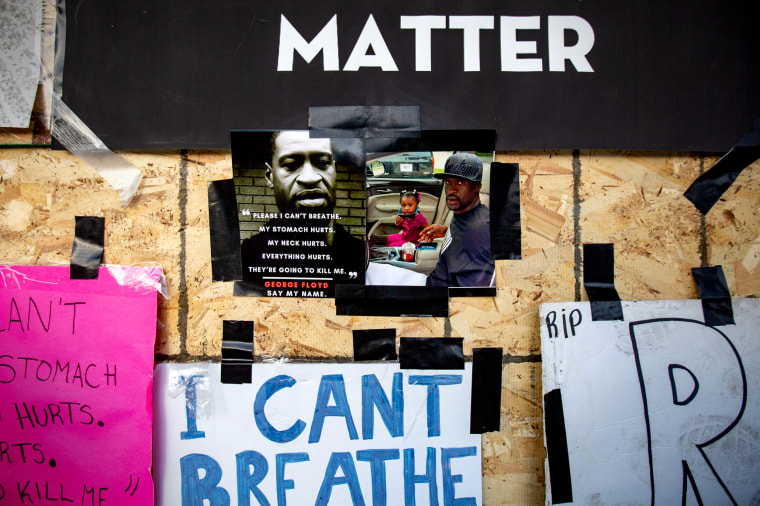Before his name became a rallying cry for Americans fed up with the police killings of unarmed black men, he was an aspiring Houston rapper nicknamed “Big Floyd” whose lines were steeped in the lore of his beloved Third Ward neighborhood.
George Floyd was part of an influential hip-hop collective called the Screwed Up Click that emerged in the 1990s with a distinct slowed-down sound that some say moved at the pace of the steamy city on a hot summer night.
His deep-voiced drawl was featured on at least a dozen mixtapes created by the group’s leader, Robert Earl Davis Jr., aka DJ Screw. And always, the focus of Floyd’s freestyling was on the things that mattered most to him: hanging with friends, dreaming about making his mark, home.
But when Floyd died on May 25, beneath the knee of a Minneapolis police officer, he was five years and more than a thousand miles removed from the historic center of African American culture in Houston where he grew up in the Cuney Homes housing project.
And when Floyd returns home to Houston on Monday for a public memorial, it will be in a coffin.
“It’s going to be a big deal for our city to bring him home,” said Houston Police Chief Art Acevedo.
Where did Floyd grow up?
Houston may have been home, but Floyd was born 46 years ago in Fayetteville, North Carolina, and moved to Texas as a child. At 6-foot-6, Floyd towered over his classmates at Yates High School, where he was a star tight end and a basketball player.
Donnell Cooper, a former classmate, told The Associated Press that Floyd may have been fearless on the field, but he was reserved off it.
“Quiet personality but a beautiful spirit,” Cooper said.
One of his friends from the neighborhood was former NBA player Stephen Jackson, who nicknamed Floyd “Twin” after noticing a resemblance.
"The first question we asked: 'Who's your daddy, Who's your daddy?' And it went from there," he said. "We always hung together, every time I went to Houston, it was my first stop to pick him up."
Where did Floyd go to college?
Floyd attended South Florida Community College (now South Florida State College) for 1993 to 1995 and played on the school’s basketball team. But he returned home to Houston before graduating.
Where did Floyd work?
A childhood friend, Christopher Harris, convinced Floyd to move to Minneapolis around 2014 and start a new life. They had mutual friends there and Floyd quickly found a job working as a security guard at a downtown Salvation Army store.
Later, Floyd juggled two jobs, as a truck driver and a bouncer at the Conga Latin Bistro.
"He's more than an employee, he's a close friend,” bistro co-owner Jovanni Thunstrom said. “He's like a brother to me.”
Because of the pandemic and the economic shutdown, Floyd was out of work the day he died.
What was Floyd being arrested for?
The owner of Minneapolis Cup Foods, a grocery store that Floyd sometimes shopped at, called the police to report that Floyd had used a phony $20 bill.
Floyd "may not have even known that the bill was counterfeit,” store owner Mike Abumayyaleh told NBC's Gabe Gutierrez.
Floyd was standing outside the store when the police arrived.
Did Floyd resist arrest?
The most recently released video appears to show that four Minneapolis officers struggled with Floyd in the back of a patrol car before Officer Derek Chauvin pinned him to the ground by kneeling on his neck.
State charging documents allege that Chauvin had his knee on George Floyd’s neck for 2 minutes and 53 seconds after Floyd became nonresponsive, based on law enforcement review of body-worn camera video.
In total, the complaint says Chauvin had his knee on Floyd’s neck for 8 minutes and 46 seconds, and “police are trained that this type of restraint with a subject in a prone position is inherently dangerous.”
A witness captured video that went viral on social media, showing Floyd on the pavement pleading with Chauvin.
"Please, please, please, I can't breathe," the man repeatedly said. "My stomach hurts. My neck hurts. Please, please. I can't breathe."
Outrage over the incident has sparked nationwide protests.
How did Floyd die?
Authorities in Minnesota said Monday that George Floyd's death was a homicide that occurred while he was being restrained by law enforcement.
The Hennepin County medical examiner said an autopsy listed Floyd's cause of death on May 25 as "cardiopulmonary arrest complicating law enforcement subdual, restraint, and neck compression."
Pathologists hired by Floyd's family said Monday that they had concluded that he died after blood and air flow was cut off to his brain, causing him to die by mechanical asphyxia.
Did Floyd have a criminal record?
Citing court records, The Houston Chronicle reported that Floyd had several brushes with the law, starting with a 1997 drug charge in Houston. His last case was an aggravated robbery with a deadly weapon charge in 2007, which resulted in a conviction and a five-year prison sentence.
Did Floyd have children?
Floyd's survivors include a 6-year-old daughter, Gianna, who lives in Houston with her mother, Roxie Washington, The Houston Chronicle reported. He also had another daughter from an earlier relationship.
“He was a gentle giant,” Washington told the newspaper. “People mistake him because he was so big that they thought he was always a fighting person, but he was a loving person…. and he loved his daughter.”

